As your baby starts to become more mobile, it’s important to make sure that their environment is safe. One key factor in ensuring your baby’s safety is knowing when to lower your child’s crib height.
Let’s be honest, there’s a lot of cute videos out there of young toddlers crawling out of their crib, sometimes with a sibling’s help. However, this behavior doesn’t always have a happy ending.
Falling from a crib or bassinet is a common accident, with 6000 children treated for such falls per year in the United States alone (which doesn’t count all the falls that happen where a child isn’t taken to the hospital).
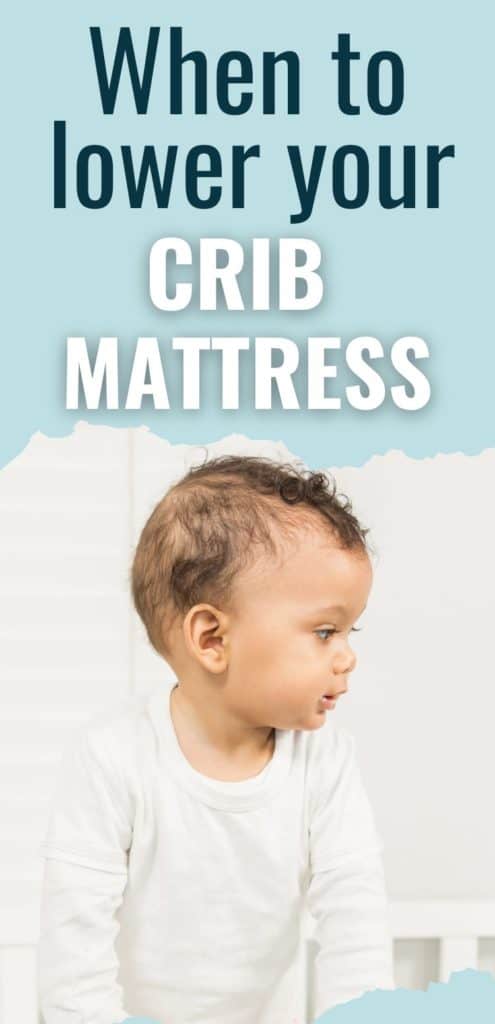
Disclosure: This article contains affiliate links. As an Amazon Associate I earn from qualifying purchases. You can read my full policy here.
I know you want what’s best for your child, so let’s learn everything you need to know about when to lower your baby’s crib mattress.
Table of Contents
AAP crib height recommendations
As any parent knows, keeping your baby safe is always a top priority. One way to do this is to choose a crib that meets the latest safety standards. The Consumer Product Safety Commission (CPSC) recommends that parents look for cribs with slat spacing of less than 2-3/8 inches (about the width of a soda can), with a snugly fitting and firm mattresses.
Drop side cribs were once very popular, but the AAP now warns against them due to the risk of entrapment and serious injury.

Since babies are often curious and active, falls are common. The most common falls occur when a baby tries to climb out of the crib. That’s why the AAP recommends moving your child to a toddler bed when he is 35 inches (89 cm) tall, or when the height of the side rail is less than three-quarters of his height.
Federal regulations have also set minimum standards for cribs in order to further reduce the risk of injury. The minimum distance between the top of the mattress support and top of the crib side rail must be 26 inches, and this height must include a 6-inch thick mattress. When a mattress is used with the crib, the actual height of the crib side as a barrier is 20 inches.
By following these guidelines, you can help ensure that your child stays safe and sound while sleeping.
Do baby cribs expire?
It’s important to keep your baby’s environment as safe as possible, and that includes their sleeping area.
While it might seem like an old crib could be just fine, the truth is that they can actually pose a serious risk to your child. Cribs typically have a lifespan of around 10 years, after which they should be disposed of. This is because over time, the various components of the crib can become loose or broken, creating gaps that a baby could potentially pass through.
In addition, the slats on older cribs are often wider than 2 3/8 inches, which can pose a strangulation hazard. Another danger? Crib posts which are above the sides more than 1/16 inch. These can snag on children’s clothing.
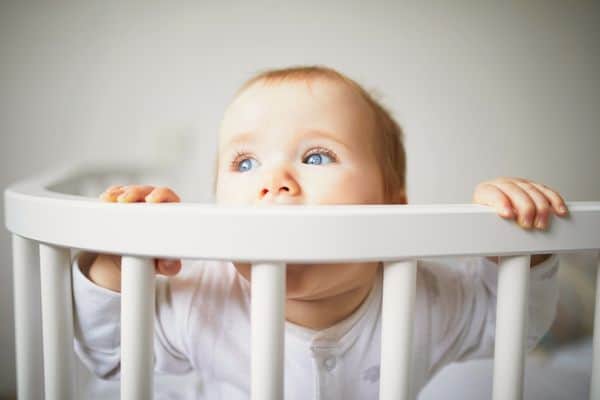
Older cribs may have other outdated features as well, such as a dangerous drop side or even lead paint (which is toxic when chewed on). For these reasons, it’s always best to err on the side of caution and get a new crib when yours reaches the 10-year mark.
RELATED: Is an organic crib mattress worth it?
How to raise a crib mattress
When you first put your crib together, you’ll likely want to raise the mattress to the highest setting. This will make it easier to put your baby in and out of the crib. To do this, you’ll need to remove the mattress so you can access the frame below. Refer to your owner’s manual for instructions on how to do this.
Once the mattress is in place, don’t use any additional towels or cushions underneath it unless instructed by your pediatrician. This can create a suffocation hazard for your child.
When should I lower my crib?
There’s no need to wait until your baby starts pulling up to lower their crib – once they can sit unsupported, you should adjust the mattress to its lowest setting. For most babies, this happens between 5 and 8 months old.
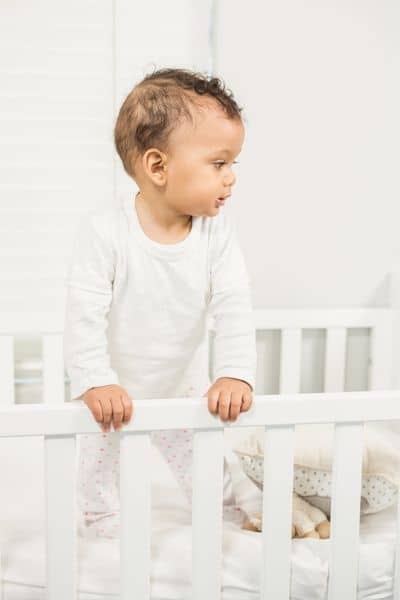
It’s important to lower your baby’s crib before they learn to stand, as per the recommendation of the American Academy of Pediatrics (AAP). This will help prevent them from climbing out and injuring themselves.
You may be tempted to wait as long as possible to drop the crib mattress. After all, it’s harder to get them into the crib asleep when the mattress is lower down! However, that’s not a good idea. You never know when a baby is going to hit a new milestone, and pulling up to stand can happen suddenly. So make sure you go ahead and make the adjustment once your child is sitting on their own.
How to lower a crib mattress
When your baby starts to sit up or pull to a standing position, it’s time to lower the crib mattress. This will help prevent your child from climbing out of the crib and prevent injuries if they should fall.

Lowering the mattress is fairly easy to do and only takes a few minutes. Simply remove the mattress from the crib and then re-install the frame at the lower setting. You can refer to the manufacturer’s instructions for more details.
Once you’ve lowered the crib mattress, make sure to put any toys or pillows out of reach so that your baby can’t use them to climb out (there should be no toys or blankets in your child’s crib during the first year anyways). By taking these precautions, you can help keep your child safe and sound during their nap time.
How to put baby into a lowered crib
There are a few things you can do to help your baby stay asleep when you put them down after rocking or nursing them to sleep (for the record, no, I don’t recommend trying to put your child to bed “drowsy but awake.” That’s basically impossible and can be so stressful you both. The biological norm is for your child to fall asleep with you).
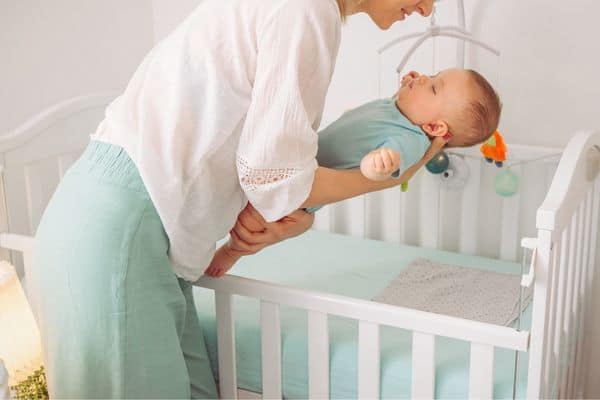
One of the biggest things that can shock a baby out of sleep is their startle reflex. For a small baby (under 4 months) swaddling can be helpful. These Zippy Swaddles from Sleeping baby are perfect.
RELATED: Zipadee Zip wearable baby blanket review
If your baby is older, a sleep sack can be helpful (like the Zipadee Zip flying squirrel).
(And now I’m sad because my little guy has outgrown his adorable Zipadee Zips… sigh.)
When lowering your child down to the crib, exhale and engage your core muscles to protect your back. Keep your little one mostly horizontal, but allow your child’s feet to touch the mattress first to help ease them down.
NOTE: If you’re having a hard time doing this, give yourself some grace. It can be hard to get your baby into their crib, especially if they’re going through a sleep regression.
But with a little bit of patience and practice, you and your baby will find a nighttime routine that works for everyone.
When to transition to a toddler bed
Making the switch to a toddler bed and a big-kid bedroom is a big milestone for your little one—and for you! Here are a few things to keep in mind when transitioning to a toddler bed:
- Most falls occur when a child is trying to climb out, so it’s important to make the switch before they’re 35 inches (89 cm) tall, or when the height of the side rail is less than three-quarters of their height – about mid-chest level.
- You can move your child to a toddler bed as early as 18 months, but some kids may not be ready until they’re 2 or 3 years old. It’s important to listen to your child and follow their cues.
- Some kids may be hesitant to sleep in a “big kid bed.” If this is the case, you can try putting a mattress on the floor for a few nights until they get used to it. Especially if you are transitioning your child out of your room, you’ll need to have a little extra patience.
Conclusions on when to lower your baby’s crib mattress
Lowering the crib mattress is an important safety precaution to take when your baby starts sitting up. It’s also a good idea to make the adjustment before they begin pulling to stand, as you never know when they will do so.
And while putting your baby down in their crib can be difficult once you lower it, it helps if you have a sleep sack that keeps your child’s arms gently nestled close.
By following these tips, you can help keep your child safe and sound during at bed time. Let me know if you have other questions on when to lower your crib mattress.
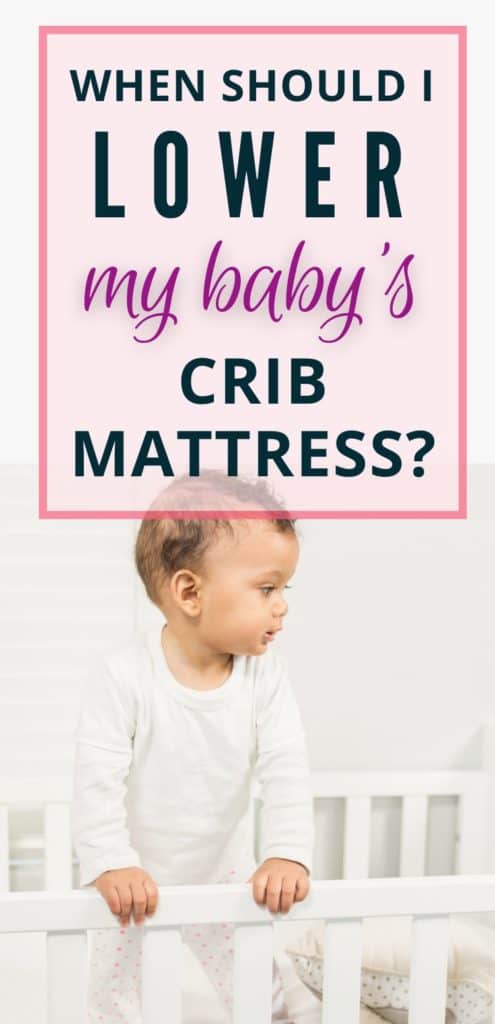

I’ve been wondering about when to lower my baby’s crib. Thanks so much!
You’re so welcome Alfie!